DONATIONS
Make a mark!
![]()
Your donation for Heinfels Castle.
On Heinfels, walls and towers connect in a unique way with the inhabitants of times long past. In 1210 the highest tower was built on the rock and marked a new reign. After the residential wing and curtain wall, the castle chapel was built in 1280. The castle was now owned by the once powerful Counts of Gorizia.
The young Count brothers Johann and Leonhard continued to expand Heinfels and in 1460 chose the fortress as their residence. After the Gorizia Counts died out, the future Emperor Maximilian I of Habsburg also inherited the mighty castle and stayed here several times. In 1525 Heinfels was stormed and occupied by its own subjects in the course of the Peasant Wars. Heinfels was home to the princely armoury, the tax registers, sacred treasures and dungeons. Famous prisoners of Heinfels were the Christian reformer Jakob Hutter and the couple accused of sorcery, Thurn Urban and Ursula. Unique are the storm piles on the curtain wall from 1620, which were supposed to prevent the construction of ladders and storming. However, it was not the external enemy that brought Heinfels down, but the futility and vacancy of the venerable walls. In 1917, 1928 and 1932 the core castle collapsed and Heinfels fell to ruin. From 2016 to 2020, Heinfels was restored and made accessible to the public to fill visitors surrounded by stone witnesses with history!
Heinfels Castle, and the eponymous district court, were built on the territory of the Prince-Bishopric of Freising, Innichen. In 1239, Otto Welf, from the House of Welfsberg, starts calling himself ‘de Hunenvelse’ (he who comes from Heinfels). The castle was first named in 1288 and the original building hails back to the last quarter of the 13th Century, and is composed by the keep, jutting out from the highest point of the rock on which the castle is perched, the palas built to the west of the structure and the castle walls stretching out to the west. Back in the 13th century, Heinfels was transferred to the House of Görz and, in 1271, Count Meinhard II of Tyrol decided to keep it for himself, going against the agreement concerning the division of the family goods he had stipulated with his brother Albert. It was only in 1275 that Meinhard gave the castle to his brother, Albert II of Görz. Heinfels was the most important hub in County Görz in the Pustertal valley until the Görz line died out. In the past, a square tower used to rise to the east of the castle structure (today it has been incorporated into the western walls). This tower was the former residence of the Count of the castle who acted as trustee of the property. The castle chapel, dedicated to Saint Laurentius, contains remains of frescoes hailing back to the Late Roman and Gothic period, and was consecrated a second time in 1331. Around 1400, an imposing, three-story hall - a new living area- was erected to the west across the ruins of the old castle walls. It still dominates the western side of the castle structure to this very day. Still in the possession of the Görz family, the castle was fortified at the end of the 15th century with an extended wall and round corner towers.
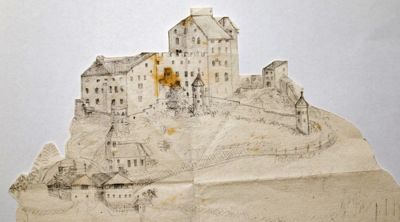
After the Görz dynasty died out around 1500, Heinfels and the whole county went to Emperor Maximilian I. Between 1654 and 1783, the castle went to the Royal Convent in Hall, then became state property. In 1833, the castle was transferred to those 18 municipalities that resided in the former county of Heinfels. It was used to shelter the poor and homeless. Between 1880 and 1910, the castle was used as a military barracks. The market town of Sillian became the sole owner of the castle in 1936, making it into a private property.
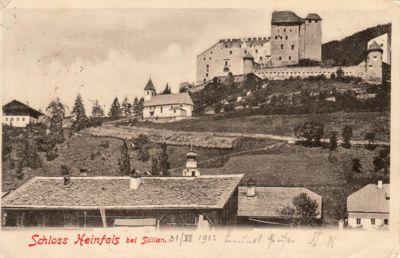
During the 18th century the castle slowly started falling in disrepair. The ceiling of the palas collapsed in 1917; the tower ceiling followed next in 1928; the western wall of the palas crumbled to bits in 1932. From this moment on, regular redevelopment work is carried out and, since the 90s, has included securing the building stock as well as a partial restoration of individual parts of the structure to their original glory.
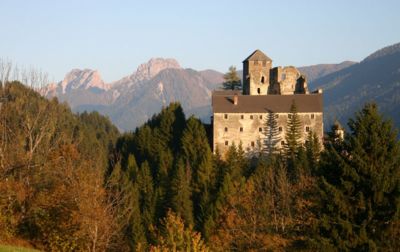
In 2007, the Loacker company, in agreement with the communities of Heinfels and Sillian, acquired Heinfels Castle with the intention of revitalising the site. The main objective was to make the castle accessible to the public again and to make it a centre of public life in Alta Pusteria, especially in terms of culture and tourism. The aim is a mixed public and private, gastronomic use. In order to achieve this, the first step was to carry out a sustainable, fundamental renovation of the castle as a matter of great urgency in order to prevent further decay of the castle complex and to preserve it for future generations as a castle complex that is visible from afar and filled with life.
From 2016 to 2020 the extensive restoration of Heinfels Castle and the establishment of a museum took place. All of this was only possible thanks to a joint and coordinated effort on the part of the Museum Association Burg Heinfels, the State of Tyrol, the Federal Office for the Protection of Monuments, the communities of Alta Pusteria, the Loacker company, but also the local population and economy.
Support our association and become a member. Just fill in this form – we’ll get back to you right away

The founding members are the municipalities of the Osttiroler Oberlandes Heinfels, Sillian, Außervillgraten, Innervillgraten, Kartitsch, Untertilliach, Obertilliach, Abfaltersbach, Strassen as well as the Loacker family: The aim is to create a possibly far-reaching, cross-border membership base with a strong focus on culture, the economy, tourism, politics, and open partnerships. Natural and legal persons as well as partnerships can become members of the association.
Ours is a non-profit association and our aims are to carry out ideal projects without a financial return. According to the statues, the aim of the association is to:
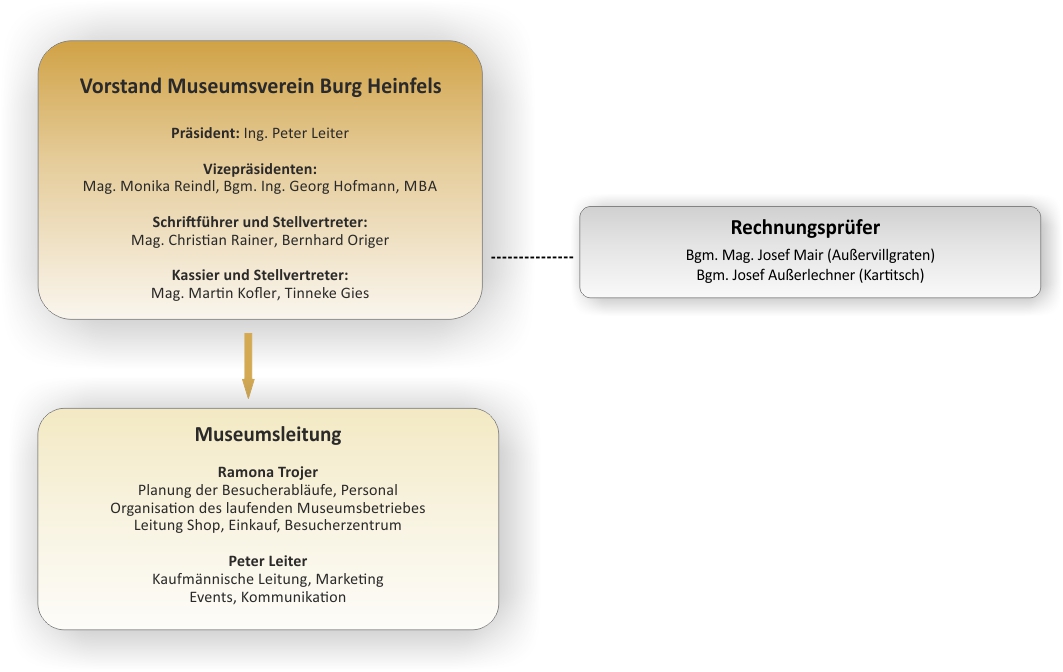
Registrations in the Registry Office in Heinfels • Yearly membership fee: € 40
The Museumsverein Burg Heinfels is recognised as a tax-free association. Therefore, 10% of the profits of a company and 10% of sales for private individuals can be declared as tax-deductible.
The association will list its sponsors on its own homepage and the Castle Heinfels website with their name and logo.
Bank coordinates: Raiffeisenbank Sillian
IBAN: AT32 3636 8000 0009 9499 oder
AT37 3636 8000 0010 2319
BIC: RZTIAT22368
UID: AT U69589938
ZVR: 749588216
The following royalty-free material can be downloaded in print-ready resolution for your press releases.
Credits: Peter Leiter/Museumsverein Burg Heinfels
 |
Logo Museumsverein Burg Heinfels | JPG, 300 dpi |
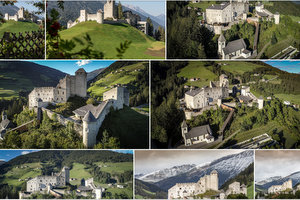 |
Photo gallery Heinfels Castle (from 2020), continuously updated! Copyright: © Peter Leiter/Museumsverein Burg Heinfels |
>>> Gallery |
For several centuries Heinfels Castle was exposed to decay. The owners, the communities, the state and the federation, with the support of the region and the population, now want to close the castle and give the "Queen of the Puster Valley" a new lease of life.
The names of the donors are visibly engraved in gold, silver or bronze in the museum shop, staircases or entrances to the castle. In addition, donors receive a duplicate and a donation receipt in the form of a donation certificate.
Leader project Heinfels Castle: development of a museum concept
Development of a basic museum concept with realisable content from existing ideas and new creative approaches.
Implementation in visualisation concepts and didactic specifications for the structural implementation.
Für das Interreg V A - Projekt Türme und Burgen
Für das Interreg V A - Projekt Kulturelle Aufwertung der Kirche S. Margeritha in Vigo und der Kapelle S. Laurentius von Burg Heinfels

Interreg V-A Italia-Österreich ITAT 2002
Interreg V-A Italia-Österreich ITAT 4018